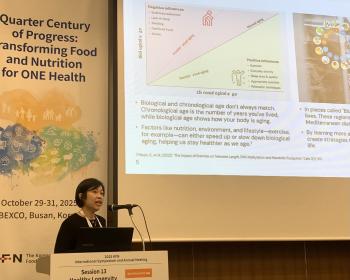I didn't have any symptoms… Hard-to-detect bile duct cancer, only 30% of surgery is possible
Jun 05, 2025
|
Bile duct cancer, like pancreatic cancer, is difficult to diagnose early, and most of them are found in advanced conditions, making surgery difficult in many cases. It is also known as a cancer with a worse prognosis than pancreatic cancer due to its low effectiveness in chemotherapy. Because of these characteristics, prevention, early diagnosis, and selection of the most appropriate treatment at the time of diagnosis are of paramount importance for bile duct cancer. With the help of Professor Kim Hyo-jung of the Department of Gastroenterology at Guro Hospital of Korea University, we summarized bile duct cancer.
◇Korea's biliary tract cancer incidence rate'2nd in the world'…The increase is serious
Bile duct cancer is generally classified as a rare cancer, but the situation in Korea is somewhat different. According to the 2022 World Report, the incidence of biliary tract cancer including bile duct cancer, gallbladder cancer, and duodenal papillary cancer is the second highest in Korea worldwide. However, except for Chile, where gallbladder cancer accounts for the majority, Korea has the highest incidence and mortality rate among all biliary tract carcinomas.
Although Korea's high level of medical care and systematic systems such as national cancer registration projects have partially affected these figures, the number of actual bile duct cancer patients continues to increase in domestic reports, and medical staff who treat them on the front lines are also experiencing the increase. As such, prevention, early diagnosis, and selection of the most appropriate treatment at the time of diagnosis are the most important diseases of bile duct cancer.
◇ No initial symptoms, diagnosing and threatening simultaneous survival
The bile duct has a structure that spreads in several directions like blood vessels inside the liver and then merges into one to come out of the liver. For this reason, it is divided into intrahepatic bile duct cancer and extrahepatic bile duct cancer depending on the location of cancer. In particular, intrahepatic bile duct cancer is hidden in organs called the liver, so the tumor is not exposed and does not cause pain in the early stages. Pain or liver dysfunction appears in blood tests only when the tumor is quite large and protrudes out of the liver or invades a large area of the liver.
Extrahepatic bile duct cancer also has no special physical changes or subjective symptoms until the bile duct outside the liver is completely blocked and bile discharge is blocked, and most of them have already progressed considerably by the time symptoms appear and lead to examination.
A typical symptom of bile duct cancer is jaundice, characterized by yellowing of the whites of the skin or eyes and darkening the urine color. In addition, abdominal pain, weight loss, loss of appetite, and unprovoked itching can be accompanied.
◇Early diagnosis is difficult even after a medical examination
Intrhepatic bile duct cancer can be detected by ultrasound when the tumor is more than 1 cm in size, but extrahepatic bile duct cancer, which is common in Korea, is different. Since ultrasound can only observe a small portion of the extrahepatic bile duct, early diagnosis is difficult with a general medical examination. In addition, since the bile duct wall is very thin within 1mm, even if cancer occurs and the wall thickens, the change is insignificant, making it difficult to detect even minute changes in the early stages even with precision imaging such as computed tomography (CT) and magnetic resonance imaging (MRI). In addition, bile duct cancer tends to grow slowly along the wall of the bile duct, and the proliferation toward the lumen proceeds slowly, so cancer is often quite advanced at the time the patient visits the hospital.
Blood tests specific to the diagnosis of bile duct cancer do not exist to date. Although CA 19-9, known as a pancreatic cancer marker, is also used in bile duct cancer, it is a non-specific indicator and has low sensitivity and specificity. In particular, levels can rise even in inflammatory biliary tract diseases, so there is currently no effective blood marker specialized for bile duct cancer.
◇Only 20% to 30% of the total can be operated...Multidisciplinary treatment is important
Bile duct cancer can only be operated in about 20-30% of all patients. The main reason why bile duct cancer surgery is difficult is that the bile duct is located closely with anatomically complex structures, and in particular, major blood vessels and organs such as the portal vein, hepatic artery, and liver tissue are concentrated in the case of bile duct cancer, which is the most frequent, requiring high-level surgery. In addition, bile duct cancer has a characteristic of spreading slowly along the bile duct wall, so the actual extent of invasion is often wider than the visible lesion, so the rate of complete resection that can be expected to be cured is very low.
If surgery is difficult, chemotherapy (targeting drugs and immuno-cancer drugs) is first performed to reduce the size of cancer and slow the progression of the disease.
In addition, treatment such as stent insertion is performed in parallel to prevent cholangitis that may occur due to bile duct obstruction and facilitate bile discharge, which is a very important treatment for patients to maintain their daily lives and improve their quality of life.
Bile duct cancer is difficult to detect early because there are no specific blood markers, and imaging tests and clinical judgments are complicated in deciding whether to operate. For this reason, bile duct cancer surgery requires high-level skills and experience, and multidisciplinary treatment is essential in which various medical departments such as internal medicine, surgery, and radiology cooperate for evaluation, treatment, and prognosis management before and after surgery.
◇Risk of eating raw fish...Active treatment of diseases such as cholelithiasis and hepatitis
Bile duct cancer cannot be completely prevented, but reducing risk factors can reduce the likelihood of developing it. A typical cause among them is liver fluke (Gandistoma) infection, which can be infected when freshwater fish are consumed raw. Cirrhosis causes chronic inflammation by being parasitic on the bile duct, and increases the risk of developing bile duct cancer over time. In particular, Korea is considered one of the countries with a high rate of liver fluke infection as the culture of enjoying freshwater sashimi still remains in some regions. Therefore, eating freshwater fish raw is very dangerous and must be avoided.
In addition, it is important to properly treat diseases that cause inflammation of the bile duct, such as cholelithiasis, bile duct gallstones, and chronic hepatitis, and to regularly perform liver function blood tests and abdominal ultrasound or CT imaging tests in chronic inflammatory patients.
|
This article was translated by Naver AI translator.















